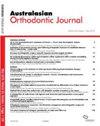新西兰正畸医生的透明矫治器治疗程序和规程
IF 0.9
4区 医学
Q4 DENTISTRY, ORAL SURGERY & MEDICINE
引用次数: 0
摘要
摘要 目的 调查新西兰正畸医师的透明矫治器疗法(CAT)程序和协议。方法 邀请新西兰正畸医师协会的110名正式会员完成一项电子调查。问题涉及受访者的人口统计学特征、矫治器的选择和使用、CAT 计划和治疗方案、病例选择、患者报告的 CAT 问题以及受访者的相关意见。此外,还调查了受访者不提供 CAT 的原因。结果 答复率为 70%。大多数受访者(88.3%;N = 68)表示,他们使用 CAT 作为一种治疗方式,其中 43.15%(N = 29)的受访者每年治疗 1 到 20 名患者。最主要的计算机辅助矫正系统是隐适美矫正器(70.3%;N = 45),49.2%(N = 32)的受访者表示他们使用一种以上的计算机辅助矫正系统。受访者表示,在接受 CAT 治疗计划之前,总是或主要需要修改的部位是附属装置(75.6%;N = 50)和最终牙齿位置(62.1%;N = 41)。根据受访者提供的数据,中位数为0%(IQR:0,1)的初始数字化治疗方案未经修改即获批准,中位数为90%(IQR:80,99)的CAT患者需要额外的矫治器阶段。近 80% 的受访者(78.1%;N = 50)表示,他们不习惯治疗咬合过度的病例,66.7% 的受访者(N = 44)在使用 CAT 时很少或从未拔除前磨牙。32.4%的受访者(21 人)在使用 CAT 时通常或经常使用远程监控系统。43.5%的受访者(22 人)表示担心患者是否遵守 CAT 操作规程。固定矫治器能提供更好的治疗效果,这对所有不提供计算机辅助矫治的受访者(8 人)的决定有一定或主要影响。结论 尽管在新西兰,由正畸医生提供CAT是很普遍的做法,但其使用情况和程序却存在很大差异。本文章由计算机程序翻译,如有差异,请以英文原文为准。
Clear aligner therapy procedures and protocols of orthodontists in New Zealand
Abstract Objective To survey clear aligner therapy (CAT) procedures and protocols of orthodontists in New Zealand. Methods One hundred and ten full members of the New Zealand Association of Orthodontists were invited to complete an e-survey. The questions related to respondent demographics, aligner choice and use, CAT planning and treatment protocols, case selection, patient-reported CAT problems and relevant respondent opinions. The reasons for respondents not providing CAT were also surveyed. Results The response rate was 70%. Most respondents (88.3%; N = 68) reported that they used CAT as a treatment modality with 43.15% (N = 29) treating between 1 and 20 patients per year. The predominant CAT system was the Invisalign appliance (70.3%; N = 45) with 49.2% (N = 32) stating that they used more than one CAT system. The respondents reported the areas which were always or mostly in need of amendment prior to acceptance of the CAT treatment plan were attachments (75.6%; N = 50) and final tooth positions (62.1%; N = 41). A median of 0% (IQR: 0, 1) of initial digital treatment plans were approved without changes according to the respondents with a median of 90% (IQR: 80, 99) of CAT patients requiring an additional aligner phase. Almost 80% (78.1%; N = 50) indicated that they were not comfortable in treating cases with increased overbite and 66.7% (N = 44) rarely or never carried out premolar extractions when using CAT. A remote monitoring system was mostly or always used by 32.4% (N = 21) of respondents in conjunction with CAT. Concern regarding patient compliance with CAT protocols was expressed by 43.5% (N = 22). That fixed appliances provided better treatment outcomes was a moderate or major influence on the decision of all respondents (N = 8) who did not provide CAT. Conclusion Although CAT provision by orthodontists is commonplace among orthodontists in New Zealand, there is wide variation in its usage and procedures.
求助全文
通过发布文献求助,成功后即可免费获取论文全文。
去求助
来源期刊

Australasian Orthodontic Journal
Dentistry-Orthodontics
CiteScore
0.80
自引率
25.00%
发文量
24
期刊介绍:
The Australasian Orthodontic Journal (AOJ) is the official scientific publication of the Australian Society of Orthodontists.
Previously titled the Australian Orthodontic Journal, the name of the publication was changed in 2017 to provide the region with additional representation because of a substantial increase in the number of submitted overseas'' manuscripts. The volume and issue numbers continue in sequence and only the ISSN numbers have been updated.
The AOJ publishes original research papers, clinical reports, book reviews, abstracts from other journals, and other material which is of interest to orthodontists and is in the interest of their continuing education. It is published twice a year in November and May.
The AOJ is indexed and abstracted by Science Citation Index Expanded (SciSearch) and Journal Citation Reports/Science Edition.
 求助内容:
求助内容: 应助结果提醒方式:
应助结果提醒方式:


